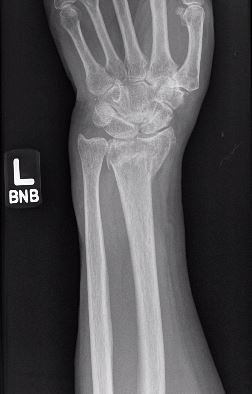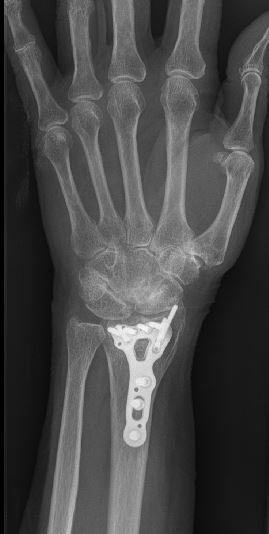Distal Radius Fractures
Distal radius fractures are one of the most common orthopedic fractures. They can occur from a low energy injury (i.e. a fall on an outstretched hand is the most common mechanism) or high energy (i.e. motor vehicle accident) injury. Often there will be a visible deformity of the wrist due to bony displacement.
The evaluating provider will order Xrays if there is a suspicion of a fracture. If the fracture extends into the joint, a CT scan may also be ordered to further evaluate the fracture to determine the best treatment option. The distal radius can tolerate a certain amount of angulation and displacement. However, there is less tolerance for displacement of the joint fragments. Your orthopedic team will know how to determine the best treatment option for your specific injury pattern.
If there is acceptable alignment of the fracture, then the wrist may be splinted for a few days then casted. X-rays will be taken a week or two later to ensure the fracture has not shifted and that alignment remains acceptable. Usually with non-operative treatment, the cast is left in place for 6 weeks at which time X-rays are taken to assess the amount of bony healing. If adequate healing, then the patient is transferred to a removable brace and therapy is often initiated to begin restoring motion. Full return to sport/activity will be determined by the orthopedic team but usually occurs at about 8-12 weeks depending on the desired sport/activity and level of bone healing.
If the injury warrants surgery, there are a few different techniques to provide adequate fixation and the best chance for healing. The most common surgical approach is performing an open reduction and internal fixation (ORIF) using a volar approach and plate and screw placement (see bottom picture). The benefits of surgical fixation is getting an excellent reduction, solid fixation and initiating early motion and reducing the risk of prolonged stiffness in the wrist.

Distal Radius Fracture with intra-articular extension of the fracture.
After surgery, a plaster splint will be placed and left in place until the initial postoperative visit at roughly two weeks. At this time, the splint will be removed, X-rays will be taken and the patient will be transitioned into a removable wrist brace and gentle therapy will be initiated to prevent further stiffness. The following protocol may be modified according to the quality of the bone and the fracture pattern. The goals of rehabilitation are to limit swelling, maintain finger motion, and gradually regain wrist range of motion and strength while protecting the fracture as it heals.
See below for Dr. Lee’s postoperative protocol.
Phase One:
Goals – minimize swelling, maintain finger range of motion, and allow wound healing
Day Zero:
- Hand and wrist elevation above the level of the heart when possible
- Bags of ice should be placed on the palm side and back side of the wrist
- Finger motion – both active and passive is instituted to prevent stiffness
Week 1-2:
- Continue the finger range of motion
- Keep the splint clean and dry
- Wean from the pain medications and transition to Tylenol for pain
Phase Two:
Goals – initiate wrist range of motion focusing first on rotation and then flexion/extension
Week 3-6:
- Begin active and passive supination and pronation
- Begin wrist extension, wrist flexion, radial deviation, and ulnar deviation as full finger motion and near full forearm rotation is obtained
- Light gripping of fingers can be performed with a foam ball
- No lifting with the wrist
Phase Three:
Goals – begin strengthening of the fingers and wrist and return to normal function
Week 7-12:

After ORIF using plate and screws.
- Wean from the splint as motion is regained
- Start strengthening of the wrist if fracture stability is appreciated by Dr. Lee or staff
- Can begin lifting with the wrist starting at 5 lbs and increasing this weight by 5 lbs every 2 weeks.
- Healing of the fracture is typically robust by 3 months and return to full function can begin at 3-4 months.
- Range of Motion and strength will continue to improve up to 12 to 18 months after surgery.
As with all surgery please call the clinic at 307-578-1955 if there are any concerns including abnormal redness or drainage around the wound, fevers, chills, numbness, tingling or increasing pain.
References:
A Prospective Randomized Controlled Trial Comparing Occupational Therapy with Independent Exercises After Volar Plate Fixation of a Fracture of the Distal Part of the Radius J. Sebastiaan Souer, MD; Geert Buijze, MD; David Ring, MD, PhD
J Bone Joint Surg Am, 2011 Oct 05;93(19):1761-1766.
Accelerated Rehabilitation Compared with a Standard Protocol After Distal Radial Fractures Treated with Volar Open Reduction and Internal Fixation
A Prospective, Randomized, Controlled Study
Jess L. Brehmer, MD; Jeffrey B. Husband, MD
J Bone Joint Surg Am, 2014 Oct 01;96(19):1621-1630.
